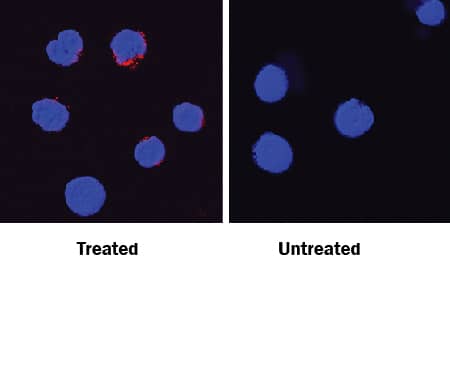Mouse IFN-gamma Antibody
R&D Systems, part of Bio-Techne | Catalog # MAB4851

Key Product Details
Species Reactivity
Validated:
Mouse
Cited:
Mouse, Transgenic Mouse
Applications
Validated:
Immunocytochemistry, Neutralization
Cited:
Bioassay, In vivo assay, Neutralization
Label
Unconjugated
Antibody Source
Monoclonal Hamster IgG Clone # H22
Product Specifications
Immunogen
E. coli-derived recombinant mouse IFN-gamma
Accession # P01580
Accession # P01580
Specificity
Detects mouse IFN-gamma in direct ELISAs. Does not cross-react with rat, cotton rat, human, rhesus macaque, porcine, feline, or canine IFN-gamma.
Clonality
Monoclonal
Host
Hamster
Isotype
IgG
Endotoxin Level
<0.10 EU per 1 μg of the antibody by the LAL method.
Scientific Data Images for Mouse IFN-gamma Antibody
IFN‑ gamma Inhibition of EMCV-induced Cytopathy and Neutralization by Mouse IFN‑ gamma Antibody.
Recombinant Mouse IFN-gamma (Catalog # 485-MI) reduces the Encephalomyocarditis Virus (EMCV)-induced cytopathy in the L-929 mouse fibroblast cell line in a dose-dependent manner (orange line). Inhibition of EMCV activity elicited by Recombinant Mouse IFN-gamma (2.5 ng/mL) is neutralized (green line) by increasing concentrations of Hamster Anti-Mouse IFN-gamma Monoclonal Antibody (Catalog # MAB4851). The ND50 is typically 4-20 ng/mL.IFN‑ gamma in Mouse Splenocytes.
IFN‑ gamma was detected in immersion fixed mouse splenocytes stimulated with calcium ionomycin and PMA (left panel) or unstimulated (right panel) using Hamster Anti-Mouse IFN‑ gamma Monoclonal Antibody (Catalog # MAB4851) at 15 µg/mL for 3 hours at room temperature. Cells were stained using an anti-hamster IgG secondary antibody (red) and counterstained with DAPI (blue). Specific staining was localized to cytoplasm. View our protocol for Fluorescent ICC Staining of Non-adherent Cells.Applications for Mouse IFN-gamma Antibody
Application
Recommended Usage
Immunocytochemistry
8-25 µg/mL
Sample: Immersion fixed mouse splenocytes stimulated with calcium ionomycin and PMA
Sample: Immersion fixed mouse splenocytes stimulated with calcium ionomycin and PMA
Neutralization
Measured by its ability to neutralize IFN‑ gamma inhibition of EMCV-induced cytopathy in the L‑929 mouse fibroblast cell line. Schreiber, R. et al. (1985) J. Immunol. 134:1609; Vogel, S. and M. Hogan (1995) in Current Protocols in Immunology. Ciocio, R. (ed); John Wiley & Sons, Inc. p. 6. 9. 1. The Neutralization Dose (ND50) is typically 4-20 ng/mL in the presence of 2.5 ng/mL Recombinant Mouse IFN‑ gamma.
Formulation, Preparation, and Storage
Purification
Protein A or G purified from hybridoma culture supernatant
Reconstitution
Reconstitute at 0.5 mg/mL in sterile PBS. For liquid material, refer to CoA for concentration.
Formulation
Lyophilized from a 0.2 μm filtered solution in PBS with Trehalose. *Small pack size (SP) is supplied either lyophilized or as a 0.2 µm filtered solution in PBS.
Shipping
Lyophilized product is shipped at ambient temperature. Liquid small pack size (-SP) is shipped with polar packs. Upon receipt, store immediately at the temperature recommended below.
Stability & Storage
Use a manual defrost freezer and avoid repeated freeze-thaw cycles.
- 12 months from date of receipt, -20 to -70 °C as supplied.
- 1 month, 2 to 8 °C under sterile conditions after reconstitution.
- 6 months, -20 to -70 °C under sterile conditions after reconstitution.
Background: IFN-gamma
Long Name
Interferon gamma
Alternate Names
IFG, IFI, IFNG, IFNgamma
Entrez Gene IDs
Gene Symbol
IFNG
UniProt
Additional IFN-gamma Products
Product Documents for Mouse IFN-gamma Antibody
Product Specific Notices for Mouse IFN-gamma Antibody
For research use only
